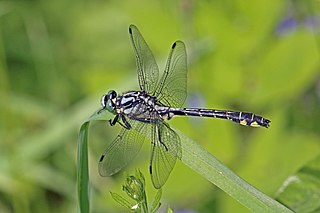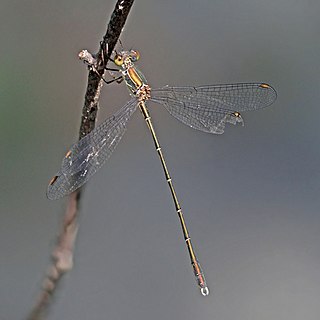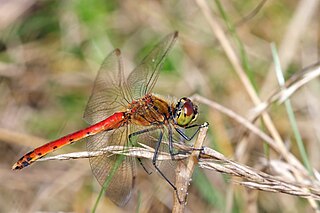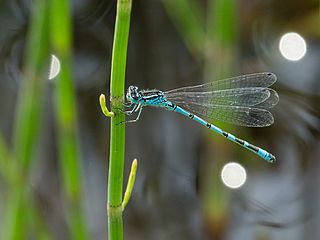
Aeshna isoceles is a small hawker dragonfly that is found in Europe, mostly around the Mediterranean, and the lowlands of North Africa. Its common name in English is green-eyed hawker. In Britain it is a rare and local species and is known as the Norfolk hawker. It has a brown colour with green eyes and clear wings and also a yellow triangular mark on the second abdominal segment which gave rise to its scientific name. It used to be in the genus Anaciaeschna as it has several differences from the other members of the genus Aeshna. Its specific name is often spelt isosceles.

The black-tailed skimmer is a dragonfly belonging to the family Libellulidae.

The migrant hawker is one of the smaller species of hawker dragonflies. It can be found away from water but for breeding it prefers still or slow-flowing water and can tolerate brackish sites. The flight period is from July to the end of October. A. mixta occurs in North Africa, southern and central Europe to the Baltic region.

The red-veined darter or nomad is a dragonfly of the genus Sympetrum.

Libellula depressa, the broad-bodied chaser or broad-bodied darter, is one of the most common dragonflies in Europe and central Asia. It is very distinctive with a very broad flattened abdomen, four wing patches and, in the male, the abdomen becomes pruinose blue.

The common darter is a dragonfly of the family Libellulidae native to Eurasia. It is one of the most common dragonflies in Europe, occurring in a wide variety of water bodies, though with a preference for breeding in still water such as ponds and lakes. In the south of its range adults are on the wing all year round.

The beautiful demoiselle is a species of damselfly belonging to the family Calopterygidae. It is found in Europe, North Africa, and Western Asia. It is often found along fast-flowing waters.

The southern hawker or blue hawker is a species of hawker dragonfly.

Brachytron is a monotypic genus of European dragonfly of the family Aeshnidae containing the hairy dragonfly, also known as the hairy hawker or spring hawker.

Trithemis annulata, commonly known as the violet dropwing, violet-marked darter, purple-blushed darter, or plum-coloured dropwing, is a species of dragonfly in the family Libellulidae. It is found in most of Africa, the Middle East, the Arabian Peninsula, and southern Europe. These dragonflies are called dropwings because of their habit of immediately lowering their wings after landing on a perch. Males of this species are violet-red with red veins in the wings, while females are yellow and brown. Both sexes have red eyes.

The white-faced darter or small whiteface is a dragonfly belonging to the genus Leucorrhinia in the family Libellulidae, characterised by red and black markings and a distinctive white patch on the head. It is found in wetlands and peat bogs from northern Europe eastwards to Siberia, and the adults are active from around April till September, which is known as the "flight period". It breeds in acidic bodies of water, laying its eggs in clumps of sphagnum moss that provide a safe habitat for larval development. The larvae are particularly vulnerable to predation by fish, and so are usually found in lakes where fish are not present. L. dubia is listed as a species of least concern (LC) by the IUCN Red List, however, it is potentially threatened by habitat destruction, pollution, and climate change.

Gomphus vulgatissimus, the common clubtail, is a medium-sized species of dragonfly in the family Gomphidae. It is found in most of Europe, and is present now in the south of France. Its natural habitats are clean, slow moving streaming rivers and creeks with sandy soil. It can be seen from mid-April in the south to August. Once they hatched out of water, they live shortly. As the common name suggests, this medium-sized species has a distinctive club-shaped abdomen. The males are black with extensive yellow markings on the thorax and abdomen which turn green as the insect ages. The females are black with extensive yellow markings. In the British Isles the adult flight period extends from mid May to early July.

Chalcolestes parvidens, formerly Lestes parvidens, is a damselfly of the family Lestidae. It has a metallic green body and at rest it holds its wings away from its body. Its common name in English is the eastern willow spreadwing.

Aeshna affinis, the southern migrant hawker or blue-eyed hawker, is a dragonfly found in southern Europe and Asia. It is in the family Aeshnidae and is very similar in appearance to A. mixta.

Anax parthenope, the lesser emperor, is a dragonfly of the family Aeshnidae. It is found in Southern Europe, North Africa, Middle East and Asia.

Lestes dryas is a species of damselfly in the family Lestidae, the spreadwings. Its common names include emerald spreadwing, scarce emerald damselfly and robust spreadwing. An alternate name in Ireland is the turlough spreadwing.

Chalcolestes viridis, formerly Lestes viridis, is a damselfly of the family Lestidae. It has a metallic green body and at rest it holds its wings away from its body. Its common name is the willow emerald damselfly, the green emerald damselfly, or the western willow spreadwing. It has an elongated abdomen and pale brown spots on its wings and resides in areas of still water with overhanging trees.

Brachythemis impartita, the Northern banded groundling, is a species of dragonfly, a skimmer from the family Libellulidae from central and northern Africa, its range extending into southern Europe and the Middle East. It was previously considered to be conspecific with B. leucosticta.

Sympetrum depressiusculum, the spotted darter, is a dragonfly species from the family Libellulidae, distributed across temperate parts of Eurasia.

Coenagrion ornatum, or, the ornate bluet, is a species of damselfly from the family Coenagrionidae distributed across a large part of Europe and Western Asia.






















